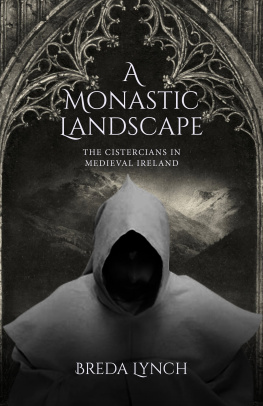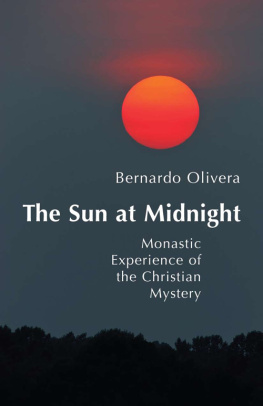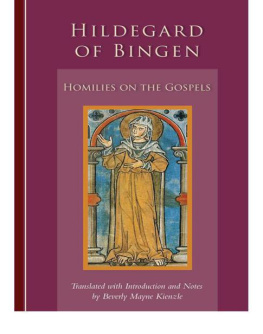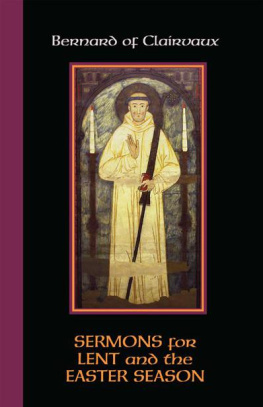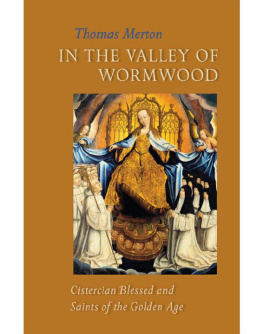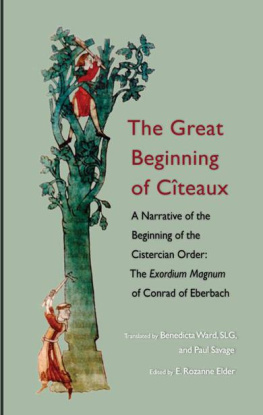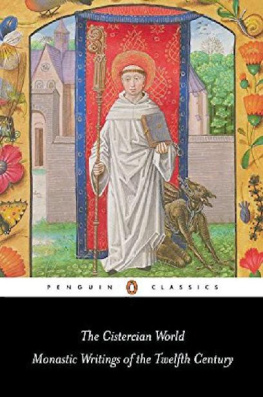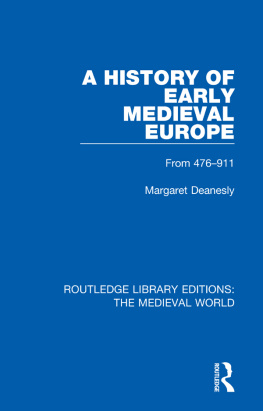
THE CISTERCIAN ORDER IN MEDIEVAL EUROPE
The Medieval World
series editor: Julia smith, The university of Glasgow
Alfred the Great
Richard Abels
ChristianJewish Relations, 10001300
Anna Sapir Abulafia
The Western Mediterranean Kingdoms
David Abulafia
The Fourth Crusade
Michael Angold
The Cathars
Malcolm Barber
The Godwins
Frank Barlow
Philip Augustus
Jim Bradbury
Disunited Kingdoms
Michael Brown
Violence in Medieval Europe
Warren Brown
Medieval Canon Law
J.A. Brundage
Crime in Medieval Europe
Trevor Dean
Charles I of Anjou
Jean Dunbabin
The Age of Charles Martel
Paul Fouracre
Margery Kempe
A.E. Goodman
Edward the Black Prince
David Green
Bastard Feudalism
M. Hicks
The Formation of English Common Law
John Hudson
The Mongols and the West
Peter Jackson
Europes Barbarians, AD 200600
Edward James
Cnut
K. Lawson
The Age of Robert Guiscard
Graham Loud
The English Church, 9401154
H.R. Loyn
Justinian
John Moorhead
Ambrose
John Moorhead
The Devils World
Andrew P. Roach
The Reign of Richard Lionheart
Ralph Turner/Richard Heiser
The Welsh Princes
Roger Turvey
English Noblewomen in the Late Middle Ages
J. Ward
THE CISTERCIAN ORDER IN MEDIEVAL EUROPE 1090-1500
EMILIA JAMROZIAK
First published 2013
by Routledge
2 Park Square, Milton Park, Abingdon, Oxon OX14 4RN
and by Routledge
711 Third Avenue, New York, NY 10017
Routledge is an imprint of the Taylor & Francis Group, an informa business
2013 Emilia Jamroziak
The right of Emilia Jamroziak to be identified as author of this work has been asserted by her in accordance with sections 77 and 78 of the Copyright, Designs and Patents Act 1988.
All rights reserved. No part of this book may be reprinted or reproduced or utilised in any form or by any electronic, mechanical, or other means, now known or hereafter invented, including photocopying and recording, or in any information storage or retrieval system, without permission in writing from the publishers.
Trademark notice: Product or corporate names may be trademarks or registered trademarks, and are used only for identification and explanation without intent to infringe.
British Library Cataloguing in Publication Data
A catalogue record for this book is available from the British Library
Library of Congress Cataloging in Publication Data
A catalog record for this book has been requested
ISBN: 978-0-415-73638-1 (hbk)
ISBN: 978-1-405-85864-9 (pbk)
Typeset in Galliard
by Graphicraft Limited, Hong Kong
Contents
First of all i would like to thank prof. Julia Smith for asking me to write this book for the Medieval World series. it has been a great pleasure to work on this volume and survey such a wide area of medieval Cistercian history. her comments, suggestions and criticism have been invaluable in the process of improving drafts; she is an exceptional book-series editor an therefore it is particularly sad that this is the final volume in the Medieval World series. The anonymous reader was particularly generous with her advice and comments helping me to improve the text considerably.
The great part of the work on The Cistercian Order was conducted dur ing research leave in the academic year 20082009, granted and financed by the school of History and the Faculty of Arts, University of Leeds. During that time I benefited from the funding of the LeedsCopenhagen co-operation fund which enabled me to spend a very productive time the Latin and Greek library of the Saxo Institute. I would like to thank Profs Christian Troelsgaard and Karsten Friis-Jensen, Mette Birkedal Bruun and Dr Mia Mnster-Swendsen for their hospitality and advice. The dis cussion with Prof. Brian Patrick McGuire of Roskilde University at the early stages of this project reassured me that I was on the right track.
However, the present book would be much poorer if not for the fellowship at the FOVOG in MayJune 2009. The wonderful library, discussion with and advice of Prof. Gert Melville, Dr Anne Mller and Dr Jrg Sonntag and lunchtime companionship of prof. Timothy Johnson, Gerd Jkel and Tobias Tanneberger enriched my understanding of monastic history. My thanks go to all members of the FOVOG.
In addition, the kind hospitality of Prof. Katariina Mustakallio, the Director of the Institutum Romanum Finlandiae, allowed me to enjoy the riches of the Librairie Franaise de Rome. I have also benefited from the feedback and comments from those who listened to my presentations on various aspects of this project at the International Medieval Congresses in Leeds, passages conferences in Tampere, Art and Ritual in Late Medieval and Early Modern Northern and Central Europe conference in Tallinn, The prelate in Late Medieval and Reformation England conference in Liverpool, and the European history 11501550 seminar at the Institute of Historical Research in November 2008: all have been very important in the process of shaping up the book.
I would like to thank Mike Spence and Richard Thomason, whose PhD projects on Cistercian intellectual and material culture I have had the pleasure to supervise for the last few years, and which have helped me to understand white monks in Yorkshire in new ways.
Finally, i would like to thank my medievalist colleagues at Leeds Axel Mller, Iona McCleery, Melanie Brunner and Richard Morris for always being so supportive.
Publisher's acknowledgements
We are grateful to the following for permission to reproduce copyright material:
Tables on pages 56 and 62 and map on pp. 7071 from Terryl Kinder, Cistercian Europe: Architecture of Contemplation published jointly 2002 by Cistercian Publications, Kalamazoo MI and by William B. Eerdmans Publishing Co,. English edition 2002 William B.Eerdmans publishing Co.
In some instances we have been unable to trace the owners of copyright material and would appreciate any information that would enable us do so.
The Cistercian Order was one of the most successful trans-European organisations of the middle ages. Its model of spirituality not only drew men and women into joining the Order but attracted support from lay patrons and benefactors. The medieval history of the Cistercians reflects many of the key social, cultural and religious trends of the central and later middle ages. It was not a story of birth, growth and decline of die Order, but one of change, development and continuity.
The present study has a number of central themes that provide an interpretative framework. First, and ever-present from the start, was the concept of reform and renewal, aspiring to recreate the original ideal of coenobitic monasticism through a return to the perfect form of observance. Second, the myths about the origins of the Order were handed down within individual communities and by the Order as a whole in foundation narratives, in institutional histories and in 'hybrid' forms of record keeping, in which thinking about the past was intertwined with the current pragmatic needs. Third, the filiation with its regional, international and cross-border links between Cistercian abbeys facilitated communications and the transfer of information and ideas in the Order and influenced career structures within the monastic communities. The fourth theme is the Order's engagement with the lay world - patrons, benefactors, neighbours, and rural and urban communities. Finally, there was the development tension between the universal (trans-European) structures of the Order and the particular local and regional aspirations of the individual houses.


